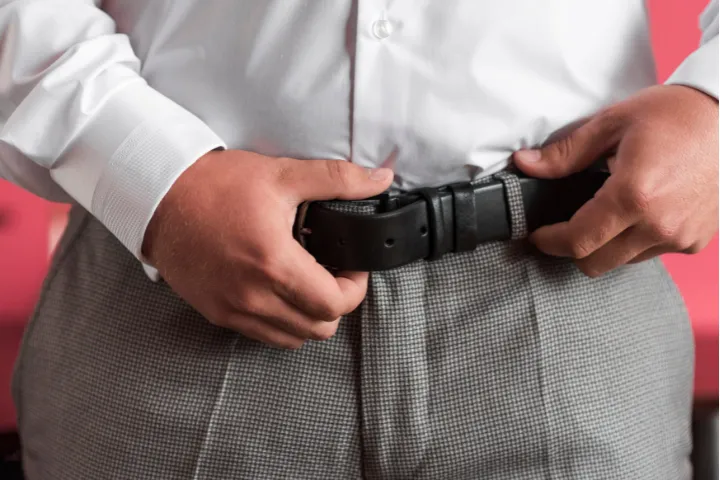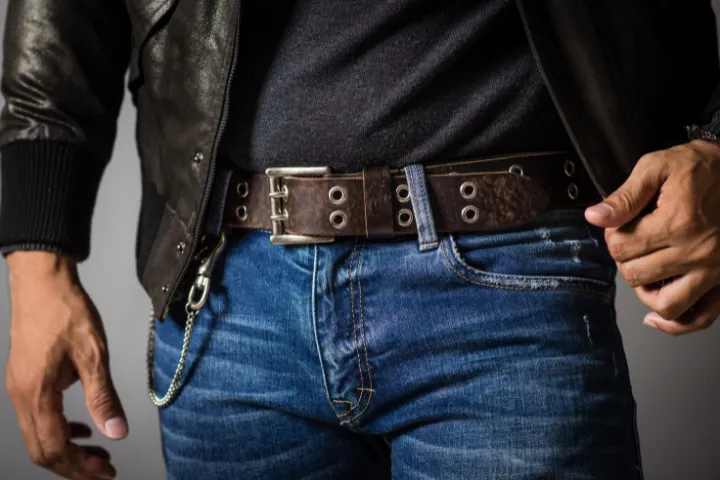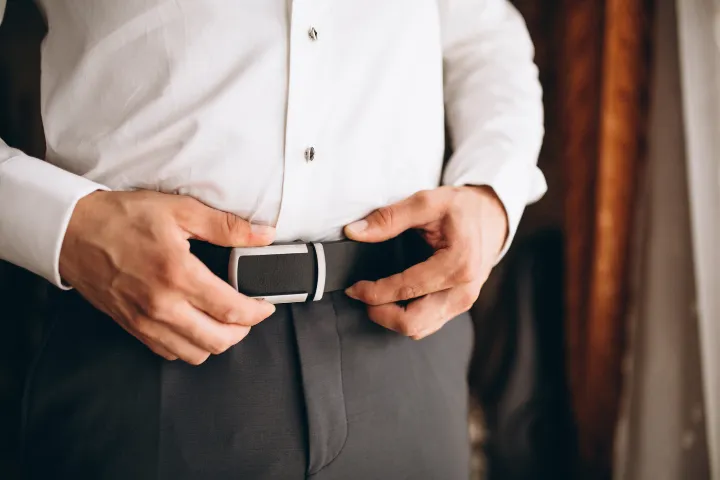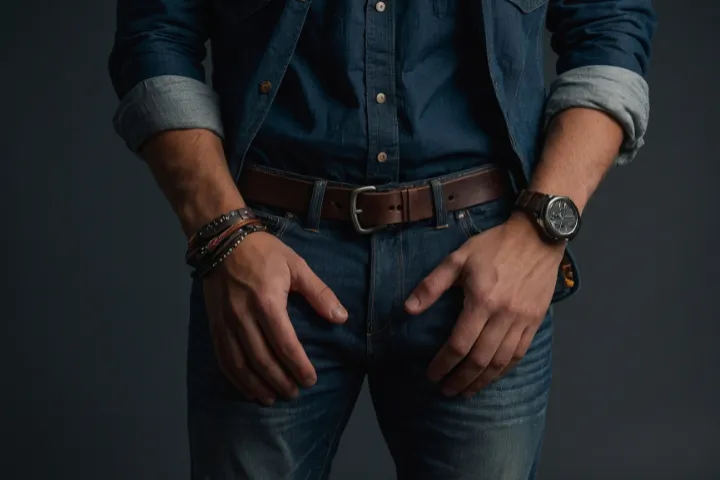A men’s leather belt is more than just a way to hold up your pants. It’s a statement piece. It’s the accessory that ties your whole look together, whether you’re in a sharp suit or a casual pair of jeans. But it’s also an area where style can go wrong. We’ve all seen it: the mismatched brown belt with black dress shoes, the belt tail that’s way too long, or the chunky buckle that clashes with a formal outfit. These small mistakes can instantly make a great outfit look sloppy.
The truth is, wearing a leather belt correctly is an art, but it’s one that’s easy to master. It comes down to understanding a few key principles of fit, style, and coordination. Unlike synthetic options that crack and peel, a quality leather belt is a durable investment that develops a unique patina over time, telling a story of its own. Getting the details right not only makes you look more polished but also boosts your confidence.
Wearing a men’s leather belt correctly involves a few simple rules. You should always match the belt’s color and finish to your shoes. The size should be your pant waist size plus two to three inches, allowing it to fasten comfortably in the middle hole. Choose a narrower width (1-1.25″) for formal suits and a wider one (1.5″+) for casual outfits like jeans. Lastly, traditionally, the belt is threaded through the loops counter-clockwise.
But this guide goes deeper than just the basic rules. We’re moving beyond simple tips to give you a professional understanding of this essential accessory. We’ll explore everything from selecting the right type of leather to advanced styling techniques that most men overlook. Imagine knowing exactly which belt to grab for any occasion without a second thought.
In this guide, you’ll discover:
- How to find your perfect belt size every single time.
- The golden rule for matching your belt, shoes, and other accessories.
- Expert styling strategies for everything from denim to dress pants.
- Simple care tips to ensure your leather belt lasts for years.
Ready to master this key piece of your wardrobe? Let’s get started.
What Is a Men’s Leather Belt and Why Should You Wear One?
A men’s leather belt is a timeless accessory that offers both function and style. It’s a small detail that makes a big impact on your overall look. Understanding its role is key to knowing when and why to wear one.
What Makes Leather Belts Special for Men?
- It’s a Natural, Durable Material: Real leather comes from animal hides, like cowhide. This makes each belt unique. Full-grain leather, the highest quality, is incredibly strong and built to last for years.
- It Ages Beautifully: Unlike faux leather that cracks, a real leather belt develops a rich, handsome patina over time. It gains character with every wear, telling your story.
- It’s a Versatile Style Piece: Leather belts are incredibly versatile. They can complete a formal suit, elevate a pair of chinos, or add a polished touch to casual jeans.
Do You Always Need a Belt with Pants?
Not always! The general rule is simple: if your pants have belt loops, you should wear a belt. It completes the outfit. However, pants without loops, like joggers or trousers with side-adjusters, don’t need one. Going beltless can also be a deliberate minimalist style choice with certain modern suits.
| Pants Type | Wear a Belt? |
|---|---|
| Jeans | Yes |
| Suit Trousers | Yes |
| Chinos | Yes |
| Joggers / Elastic Waist Pants | No |
| Trousers with Side-Adjusters | No |
How Do You Choose the Right Leather Belt?
Choosing the right leather belt is about more than just picking a color. Material, width, buckle style, and size all play a huge role in whether a belt enhances your outfit or detracts from it. Getting these details right is the foundation of great style.
What Factors Determine the Best Leather Belt for You?
- Material Quality: Always aim for full-grain or top-grain leather. Full-grain is the most durable and ages best, while top-grain offers a more polished, uniform look.
- Belt Width: For formal wear like suits, choose a narrower belt (1-1.25 inches). For casual outfits with jeans or chinos, a wider belt (1.5-2 inches) is more appropriate.
- Buckle Style: A simple, classic prong or box-frame buckle is best for formal settings. Casual belts allow for more creative and larger buckles, like automatic or Western styles.
- Essential Colors: Every man should own at least two belts: one black and one brown. A tan belt is also a versatile third option for more casual or summer looks.
- Sustainability: For an eco-friendly choice, look for vegetable-tanned leather, which uses natural tannins instead of chemicals.
How Do You Measure and Size a Leather Belt Correctly?
The easiest way to find your belt size is to add 2-4 inches to your pant waist size. For example, if you wear size 34 pants, you should look for a size 36 or 38 belt. This ensures the tail is the perfect length—long enough to tuck into the first loop, but no longer.
| If Your Pant Waist Size Is… | You Should Buy a Belt Size… |
|---|---|
| 30″ | 32″-34″ |
| 32″ | 34″-36″ |
| 34″ | 36″-38″ |
| 36″ | 38″-40″ |
| 38″ | 40″-42″ |
Which Buckle Styles Suit Different Occasions?
- For Everyday & Casual Wear: A simple prong buckle is the most common and versatile choice. It works great with jeans, chinos, and shorts.
- For Formal Attire: A sleek box-frame or automatic buckle adds a modern, polished touch to suits and dress pants. Keep it simple and elegant.
- For a Statement Look: Larger, more ornate buckles, like those found on Western belts, should be reserved for casual, confident outfits.
- A Note on Metals: Try to match the metal of your buckle (silver, gold, etc.) to your watch or any other metal accessories you’re wearing.
How Do You Wear a Leather Belt Properly?
Once you’ve chosen the perfect belt, wearing it correctly is the final step to a polished look. It’s a simple process, but getting the direction and fastening right makes all the difference. Following these conventions ensures you look sharp and put-together every time you get dressed.
What Is the Correct Direction to Put on a Belt?
You might be surprised to learn there’s a traditional direction for wearing a men’s belt. While it’s a subtle detail, following it is a hallmark of classic style.
- The Traditional Rule: For men, the belt should be threaded through the pant loops starting on the left side. This means the belt runs counter-clockwise around your waist.
- The Result: When you fasten the belt, the tail end will point to your left. This is the most widely accepted and classic way for men to wear a belt.
- Is it a Strict Rule? Not exactly. While it’s the standard, some left-handed men find it more comfortable to do the opposite. However, if you want to to stick to tradition, left-side first is the way to go.
How Do You Thread and Fasten a Leather Belt?
Properly fastening your belt ensures a secure, clean fit without damaging the leather. The goal is to have the belt sit snugly without being too tight.
- Step 1: Thread Through the Loops. Starting from the front-left loop, guide the belt through each loop around your waist until it comes back to the front.
- Step 2: Fasten the Buckle. Pull the belt until it feels snug but comfortable. If you’re using a standard prong buckle, insert the pin into the middle hole. This indicates a perfect fit.
- Step 3: Secure the Tail. After buckling, slide the tail end of the belt through the first belt loop on your pants. If your belt has its own leather keeper loop, use that first, then the pant loop. This keeps the end neat and tidy.
- Variations for Buckles: With a clip-latch or automatic buckle, simply slide the belt through and lock it in place for a custom fit. These are great for making minor adjustments throughout the day.
A quick visual check: the belt should look straight and horizontal around your waist, with no sagging or pulling. A well-fastened belt completes the clean lines of your outfit.
How Do You Match a Leather Belt with Your Outfit?
Matching your belt to your outfit is where true style shines. It shows that you pay attention to the details. The right pairing can elevate your entire look from good to great, creating a cohesive and polished appearance. The rules are simple but powerful.
Should Your Belt Match Your Shoes and Other Accessories?
Yes, absolutely. This is the most important rule in men’s style when it comes to belts. Coordinated leathers and metals create a look that is intentional and well-thought-out.
- Match Your Leathers: The color and finish of your belt should closely match your shoes. Black shoes get a black belt. Brown shoes get a brown belt. If you’re wearing shiny patent leather shoes, your belt should also be patent leather.
- Harmonize Brown Tones: While black is straightforward, brown has many shades. You don’t need an exact match, but the tones should be similar. A dark chocolate brown belt works with dark brown shoes, while a tan belt pairs with lighter tan shoes.
- Match Your Metals: The metal of your belt buckle should match your other metal accessories. If you’re wearing a silver watch, choose a belt with a silver buckle. The same goes for gold, brass, or any other metal.
Can you wear a brown belt with black shoes? In short, no. This is one of the few hard rules in men’s fashion. The clash is too jarring for both formal and casual settings. Stick to matching your leathers for a guaranteed sharp look.
How Do You Style a Leather Belt for Casual Outfits?
Casual outfits offer more freedom and personality. A leather belt is perfect for adding structure and a touch of class to your everyday look.
- With Jeans and Chinos: These are the perfect pants for a wider belt (1.5 inches is ideal). A thick, rugged brown leather belt is a timeless companion for blue jeans.
- Tuck or Untuck: Tucking in your shirt (even just the front, known as a “French tuck”) shows off your belt and defines your waistline. An untucked shirt creates a more relaxed, effortless vibe.
- Play with Texture: Don’t be afraid to experiment with different leather textures. A braided or suede belt can add a unique and stylish element to a simple chino and polo shirt combination.
How Do You Pair a Leather Belt with Formal or Business Attire?
In a formal or business setting, your belt should be subtle, sleek, and sophisticated. Its job is to complement your suit, not steal the show.
-
- Go for Sleek and Narrow: A formal belt should be on the narrower side (around 1-1.25 inches) with a simple, elegant buckle. The finish should be smooth and have a slight sheen.
- Ensure Pristine Condition: Your dress belt should always be in excellent condition. Any scuffs, cracks, or warping will stand out and detract from the sharpness of your suit.
– Belts and Suspenders: Never wear both at the same time. They serve the same purpose. Choose one or the other. If your suit trousers have suspender buttons, it’s often best to opt for suspenders for a more classic, seamless look.
What Are Advanced Styling Tips for Men’s Leather Belts?
Once you’ve mastered the basics, you can start using your leather belt to make a real fashion statement. These advanced tips are for the man who wants to stand out from the crowd and show a deeper understanding of style. It’s about moving beyond the rules and into personal expression.
How Can You Use a Leather Belt as a Fashion Statement?
Your belt doesn’t always have to be a supporting actor; sometimes, it can be the star of the show. Here’s how to give it a leading role:
- Choose Interesting Textures: Look for belts with unique finishes. An embossed or patterned leather belt adds a layer of visual interest to an otherwise simple outfit, like plain chinos and a solid-colored shirt.
- Try the Belt Knot: With a longer, more casual belt (like a fabric or thin leather one), you can tie the tail into a simple knot after buckling. This adds a relaxed, fashion-forward touch to your look. It works best with casual outfits.
- Think Seasonally: Just like the rest of your wardrobe, your belts can reflect the seasons. Lighter tan or even colored leather belts are perfect for summer. Darker shades like deep brown, burgundy, and black work best for fall and winter.
- Layer with Accessories: For a more edgy or streetwear-inspired look, you can layer accessories. A wallet chain that hangs alongside your belt can create a bold statement, though it’s best reserved for very casual situations.
Which Belt Styles Work for Different Body Types?
The right belt can also help create a more flattering silhouette. Choosing a style that complements your body type is a pro move that makes a subtle but significant difference.
- For Slim Men: A narrower belt (around 1.25 inches) is ideal. A wide, bulky belt can overwhelm a slender frame and throw off your proportions. Keeping things sleek and slim creates a more balanced look.
- For Athletic Builds: Men with an athletic frame can handle a medium-width belt (around 1.5 inches). This size is substantial enough to match a broader chest and shoulders without adding unnecessary bulk around the waist.
- For Tall or Plus-Size Men: A wider belt (1.5 to 1.75 inches) is often the most flattering choice. A thin belt can get lost on a larger frame, while a wider one helps balance proportions and provides a stronger horizontal line, creating a more defined waist.
How Do You Maintain and Care for Your Leather Belt?
A high-quality leather belt is an investment. With the right care, it can last for a decade or even longer, looking better with each passing year. Proper maintenance is simple and prevents the leather from drying out, cracking, and losing its shape. Just a few minutes of care every now and then makes all the difference.
What Are the Best Ways to Clean and Condition a Leather Belt?
Keeping your belt clean and conditioned is the most important part of its long-term care. Think of it like moisturizing your skin—it keeps the leather supple and strong.
- Regular Wiping: After a few wears, simply wipe your belt down with a soft, dry cloth. This removes any surface dust and oils that can build up over time.
- Deep Cleaning: If your belt gets dirty, use a slightly damp cloth with a small amount of leather soap. Lather it gently, wipe the belt clean, and then immediately wipe it dry. Never soak the leather.
- Conditioning: Every few months, apply a small amount of leather conditioner with a clean cloth. Rub it in a circular motion and let it absorb for a few hours before wiping off any excess. This restores moisture and prevents cracking.
- Proper Storage: Don’t leave your belt in your pants. The best way to store it is to hang it vertically by its buckle or loosely coil it in a drawer. This helps it maintain its shape. Keep it away from direct sunlight and high heat.
Do Leather Belts Stretch or Wear Out Over Time?
Yes, all leather will stretch slightly with use, especially if it’s pulled too tight. High-quality full-grain leather is much more resistant to stretching than lower grades. Over time, you might notice the hole you use most often becomes a bit elongated. This is normal wear and tear.
- Minimize Stretching: The best way to prevent stretching is to buy the correct size from the start. A belt that fits on the middle hole doesn’t need to be pulled excessively tight.
- Rotate Your Belts: If you have more than one belt, try to rotate them. Giving a belt a day off allows the leather to rest and recover its shape, which greatly extends its lifespan.
- Protect the Finish: Consider using a leather protectant spray, like a Balm Proofer. This can help repel water and stains, keeping the finish looking new for longer.
What Are Common Mistakes When Wearing a Leather Belt?
Even with the best intentions, it’s easy to make a few common mistakes that can instantly downgrade your look. Avoiding these simple errors is key to ensuring your belt always adds to your style, rather than taking away from it. Think of this as your final checklist for a perfect look every time.
Which Errors Should You Avoid with Leather Belts?
Knowing the rules is half the battle; knowing the pitfalls is the other half. Here are the most frequent mistakes to watch out for:
- The Cardinal Sin: Mismatching Leathers. The most common mistake is wearing a brown belt with black shoes, or vice-versa. It creates a visual clash that looks unprofessional and sloppy. Always match your leathers.
- The Wrong Tail Length. A belt tail that is too long wraps halfway around your hip, while one that’s too short barely makes it through the buckle. Both look awkward. Aim for a few inches of tail, just enough to tuck neatly into the first pant loop.
- Wearing a Worn-Out Belt. A belt that is cracked, faded, or heavily scuffed should be retired, especially for formal or business occasions. A damaged belt signals a lack of attention to detail.
- Ignoring the Occasion. Wearing a wide, casual belt with a formal suit is just as bad as wearing a thin dress belt with rugged jeans. The width and buckle style must match the formality of your outfit.
Is there a proper way to wear a belt? Absolutely. The proper way is to choose the right size, match it to your shoes, and select a style appropriate for the occasion. When these three elements align, you’ve mastered the art of wearing a belt.
FAQ Section
How long should a men’s leather belt be?
A men’s belt should be 2-4 inches longer than his pant waist size. This leaves a short tail to tuck into the first pant loop after buckling.
Can men wear belts with suspenders?
No, you should never wear a belt and suspenders at the same time. They both serve the same function, so choose one or the other.
What color belt goes with everything?
No single color goes with everything, but a medium brown leather belt is the most versatile. It works well with jeans, chinos, and most non-black dress shoes.
How do you break in a new leather belt?
The best way to break in a leather belt is simply to wear it. The leather will naturally soften and conform to your body over a few weeks of regular use.
Do you need to match belt and shoe brands?
Not at all. The important thing is to match the color and finish of the leather, not the brand logos.
How to fix a stretched leather belt?
Minor stretching is permanent. To prevent it, buy the correct size and rotate your belts. If it’s severely stretched, a leatherworker may be able to shorten it for you.
What is the difference between dress and casual belts?
Dress belts are narrower (1-1.25″), have a smooth finish, and a simple buckle. Casual belts are wider (1.5″+), often have more texture, and can feature larger, more decorative buckles.
Conclusion: Partner with Hoplok for Your Custom Leather Belt Needs
Mastering how to wear a men’s leather belt is a simple way to elevate your entire wardrobe. By understanding how to choose the right size, match it to your outfit, and care for the leather, you turn a simple accessory into a powerful tool for effortless style. A quality leather belt does more than hold up your pants—it showcases your attention to detail and pulls your entire look together with confidence.
Now is the time to put these tips into practice. Experiment with different styles and invest in high-quality pieces that will last. As trends move towards more sustainable and personalized fashion, a well-made leather belt is more relevant than ever.
If your brand is looking to create a line of exceptional men’s leather belts, look no further. At Hoplok Leather, we combine over 22 years of craftsmanship with modern manufacturing to produce custom leather goods for clients worldwide. We can help you design and create the perfect belts for your collection, from the choice of full-grain leather to the finish on the buckle. Contact Hoplok today to get a free quote and start creating custom leather belts that your customers will love for years to come.








